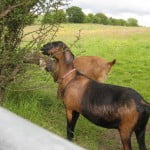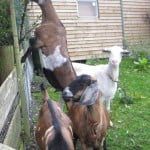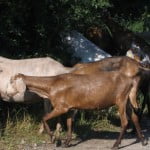Sanctuary Life
Goats do roam
They are browsing animals and want to be on the move all the time – the grass is always greener over the horizon for Miss Goat. If you live in an area where they can run free and do as they please all day, you will find that they come back home at night or when they are ready for a siesta. Goats like to lie down and chew the cud at regular intervals and prefer to do this close to home, so they like to come and go as they please. Goats will also dash for home whenever rain approaches. They hate rain and will run back to their shed whenever they feel the first spot. In America there is a goat weather station, where a goat farm is opposite local radio. Apparently they base the weather forecast on what the goats are doing! I am sure this will be as accurate as any other forecast, goats are good predictors of the weather. Keeping goats free range is the most ideal system, for them and for you. The trouble is that most of us have boundaries, fences, neighbours with gardens and once your goats have explored and eaten all the goodies on your patch they will want to move on. Fencing to keep a goat in has to be up to jailbreak standards! Miss Goat can go under, over, through and she is clever enough to open gates and untie latches and fasteners. The fencing has to be safe too or there will be broken legs and torn udders.
Hedging – a thick, mature hawthorn hedge has a good chance of keeping the goats securely in their place. While they will nibble at the leaves, they rarely go through it especially if it has been properly ‘laid’. A roll of sheep netting tacked to it in the winter will make it more secure. Never use barbed wire anywhere near goats (or horses). It’s inevitable that they will get caught up in it and hurt themselves – bloodbath and barbed wire go together – it’s cruel stuff that can cause horrific injury. A holly hedge will usually keep goats in, the problem is that both these bushes are slow to grow (the holly especially) and unless you have them already established you will have to wait a long time before they are any use. A newly planted hedge will be a nice snack if your goats get anywhere near it.
Post and rail is very good but it is expensive and goats have a habit of propping their front feet on the bottom rail to reach up and see over or get to a particularly appetising looking branch. Eventually they’ll loosen the rail and then there is a gap for you to fix or they are through. Post and rail has to be re-inforced with sheep netting, which is wire squares on a 25mt or 50 metre roll. You’ll have to staple this tightly to the fence, if it’s loose it will be dangerous and your livestock will get tangled up in it. Sheep netting works well so long as it is high enough so the goats don’t jump over it and taught enough so they don’t get their legs fast. A top rail is the best way to keep the fence secure and bear in mind that goats are able to get to quite a height when they stand on their hind legs.
Electric fencing – is just about the only system that works – the goats don’t like the mild tingle they get when they touch the fence and they’ll stay well away. We find it’s best if it’s put a little way in front of a traditional fence. You can use plastic fence posts or thin wooden stakes with plastic noggins on and thread the fence wire or tape along as far as you want. If you have mains electric fencing you can go on right round the fields, it maintains the charge over a tremendous distance. The wooden fence provides a visual marker for the goat and the electric wire keeps her away from it. Problem solved! When you have the electric fence on its own, there’s a chance that some goats will have a cavalry charge and go through it. Once they’ve done that once, it’s difficult to stop them the next time. Battery electric fencing works nearly as well, over a shorter distance though. There is a problem though and it’s not because of the goats. You can’t stop the unit being stolen. Sad people.
It’s all about food – goats want to get out to find fresh food. They are pernickety eaters, always searching for a fresh and tasty morsel. Their desire is to eat deep-rooted plants and a grass field doesn’t suit them. Woodland or scrub land is what they like most of all. If the trees are mature they usually leave them alone, they will strip all the saplings and young growth however. Goats eat most bushes, vegetables and flowers, they adore roses and although they only have one set of teeth (on the lower jaw) and a soft palate on the upper jaw, they will devour the whole stems thorns and all. I watched the goats grazing earlier in the week. I had them out for an early evening stroll – first they attacked the hawthorns, then some dandelions and docks, then elderflower branches, then grass, then nibbled at some low hanging larch, then grass, then finished up devouring some sycamore saplings. They were obviously contented when they ambled back to their goat house. This was a perfect goat supper and one they particularly enjoyed because they had a goat herd out with them – me!
We continue to campaign against ritual slaughter of goats, which is still legal in the U.K. and we rescue and provide a permanent home for as many goats as we are able. Any help you can give these gentle and affectionate creatures will be of tremendous benefit and much appreciated. [donate]



